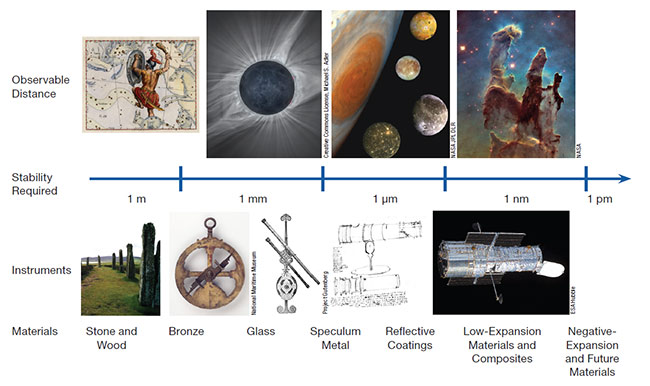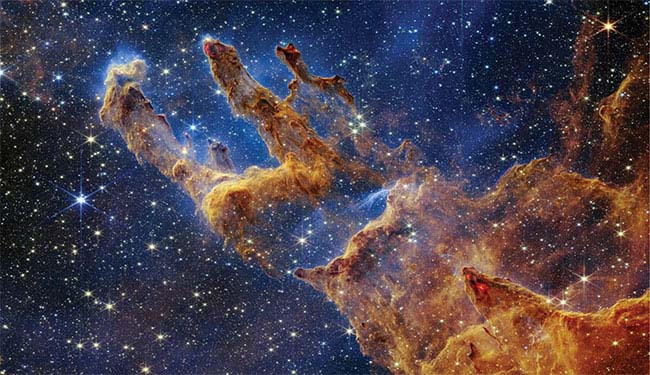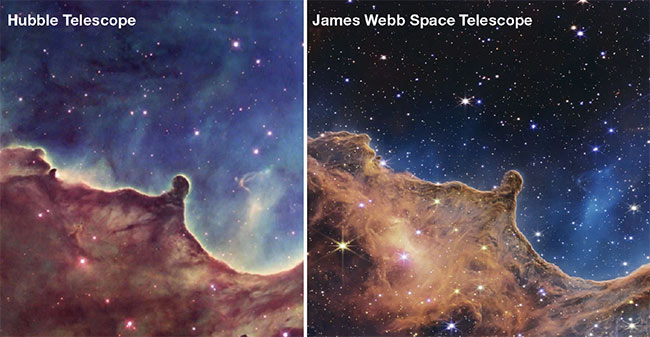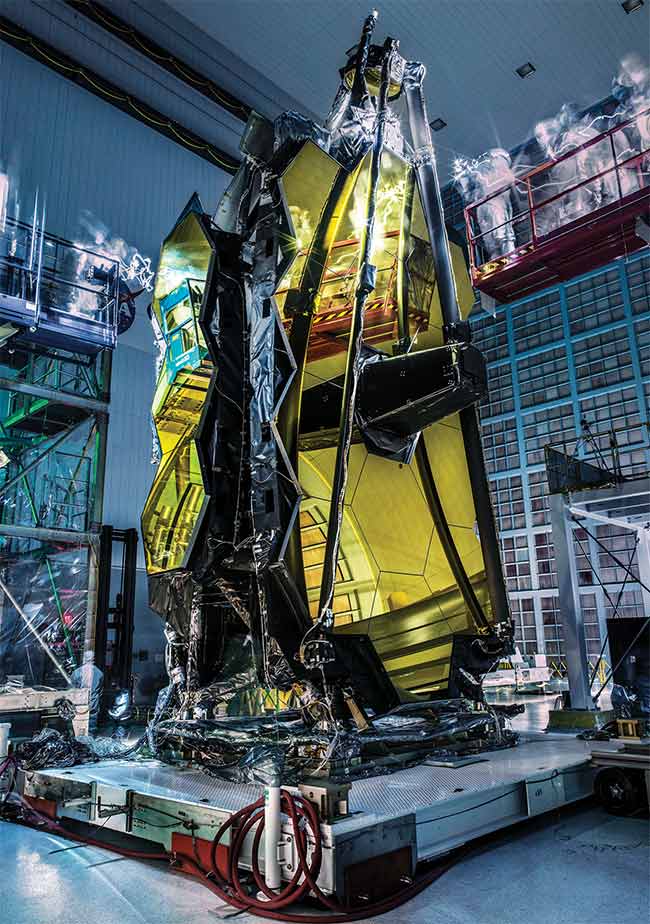
How Materials Advancements Advance Our View of the Cosmos
The telescopes, spectrometers, and other instruments humanity launches into space are among our most sophisticated tools for discovery and are themselves built from our most sophisticated materials.
JAMES A. MONROE, ALLVAR
It is strange that the study of materials has been intertwined with the study of our universe. Somewhat paradoxically, improving our grasp of atoms has enabled us to answer questions about the cosmos. Although humanity has always looked to the stars in awe, our
understanding of them has been constrained by our knowledge of geometry, algebra, physics, and materials. Throughout history, the discovery of new materials enabled the most advanced astronomical instruments of the era. These advanced instruments informed and enhanced the predictive capability of our physical, geometric, and algebraic models.
Figure 1 provides an overview of how the evolution of materials technology paced our ability to create increasingly stable astronomical instruments that have enabled us to look deeper into space. In the beginning, our ancestors looked to the skies with the naked eye where they observed patterns. Clusters of stars regularly ebbed and flowed with the seasons.
Paying careful attention to their emergence, movement, and disappearance over time provided an advantage to ancient hunter-gatherers who would learn when they needed to store resources for the winter. The agricultural societies that sprung up later also used these constellations to help them time their planting and harvesting cycles. Wood and stone were the most advanced materials of the day. Although a controversial topic, standing stones such as Stonehenge and the Ring of Brodgar may have been some of the earliest cosmological observatories. The placement of the stones would require a reliance on the order of meters to be accurate.

Figure 1. The evolution of materials technology has paralleled our ability to look deeper into space. Top: Observable images (left to right): Orion, a solar eclipse, the moons of Jupiter, the Pillars of Creation. Bottom: Instruments (left to right): Ring of Brodgar, an astrolabe, Galileo Galilei’s Refractive Telescope,
Isaac Newton’s illustration of his reflective telescope, the Hubble Space Telescope. Courtesy of ALLVAR.
As time wore on, the combination of metals such as copper and zinc produced soft, castable, and malleable bronze alloys. These new alloys enabled the first astrolabe instruments, which required millimeter-scale stability to accurately convert time into latitude and vice versa. The astrolabe and its successor the sextant enabled successful navigation of the seas.
Eventually, the creation of optically clear glass lenses enabled the first magnified observation of celestial bodies. When combined with bronze and iron housings machined to micrometer accuracy, these lenses enabled the creation of the first telescopes. After Galileo developed
improvements to the telescope for military purposes, he turned them to the
sky and identified multiple moons
surrounding Jupiter.
In the subsequent 400 years, further discoveries of and improvements in new materials technologies drove additional explorations of our universe. Isaac Newton invented the reflective Newtonian telescope with a speculum metal mirror. This speculum metal was easily cast and polished into large mirrors with micron-class precision that drove the most powerful telescopes of the 18th and 19th centuries. Telescopes of the 20th century continued to evolve with new advancements in glass, the development of reflective coatings, and the advent of composite materials. These advancements ultimately achieved the stability required for the design, creation, and deployment of the Hubble Space Telescope, launched in 1990 (Figure 2).

Figure 2. The development of low thermal expansion materials, reflective coatings, and composite materials enhanced the thermal stability of orbital telescopes, such as the Hubble Space Telescope. Courtesy of NASA ESA CSA STScl.
A key challenge to achieving the stringent stability requirements for the Hubble and other space-based telescopes is the way materials tend to expand with changes in temperature. This thermal expansion can push delicate space-based instruments out of focus. Here again, developments in materials technology helped solve the problem.
Of particular help are materials with a negligible coefficient of thermal expansion (CTE), such as iron and nickel alloys commonly referred to as Invar, Schott’s lithium-aluminosilicate glass-ceramic ZERODUR product, Corning’s Ultra-Low Expansion glass portfolio, and carbon-fiber composites.
Each material needed to be discovered, developed, and integrated into complex new platforms to capture high-quality images from space.
Happy accidents
As the stability requirements of astronomical instruments become tighter, the CTE of materials comprising these instruments has a greater impact on performance. Interestingly, many of these enabling low- and controlled-expansion materials originated from serendipitous observations.
For example, Charles-Edouard Guillaume, who won the Nobel Prize in 1920 for discovering the iron nickel alloy that became Invar, described in his Nobel
lecture a chance observation during his work making length standards for the International Bureau of Weights and
Measures. “A bar of steel containing
30% nickel arrived at the International Bureau and I found its expansibility to
be about one third less than that of platinum,” Guillaume wrote. “The continuation of a study so begun augured well and I pursued it with stubborn obstinacy.”
The origin of glass-ceramic technology
is similarly unique. Donald Stookey, a chemist at Corning in the 1950s, was heat-treating glass overnight when the furnace malfunctioned and overheated. When he discovered the furnace was too hot, he expected to find a puddle of glass on the furnace floor. To his surprise, the glass was in the same shape he left it, but it had turned white. The next surprise emerged as he pulled the glass from the furnace with tongs, and it slipped and fell on the floor. He expected the glass to break into a million pieces. Instead, it bounced across the floor and stayed intact.
Research later revealed that ceramic crystals had formed inside the glass at the furnace’s high temperatures. The result was a strong and resilient glass-ceramic composite. In addition to introducing glass-ceramic casserole dishes to households, further study of this newfound material enabled control over its thermal expansion by controlling the amount of ceramic crystallization. This led to the creation of ZERODUR, a glass material prized for its low thermal expansion.
Currently, the primary mirror segments and monolithic secondary mirror of the Extremely Large Telescope in Chile is being made from ZERODUR glass — or this “lucky accident,” as Stookey described it.
A more recent discovery in materials science led to the first bulk metals with tunable and negative thermal expansion. In 2010, James A. Monroe was a graduate student at Texas A&M University working on alloy development. While at a conference, he attended a presentation with experimental measurements that indicated that the atoms of a particular metal got closer to one another when the metal was heated — a property termed negative thermal expansion. Monroe did not believe this to be possible, though if true it could potentially lead to the creation of materials that shrink when heated and expand when cooled.
Returning to the university, Monroe worked with his advisors Ibrahim
Karaman and Raymundo Arróyave to successfully unlock the metal’s behavior in large pieces of titanium-based material that, in 2014, led to the launch of a
new class of metals dubbed ALLVAR Alloys.
When used to fabricate astronomical instruments, this unique material technology helps compensate for the expansion of other materials and components prone to more conventional thermal expansion behavior. Today, these new alloys are being integrated into the coronagraph’s thermal controls on NASA’s Nancy
Grace Roman Space Telescope. These
alloys also promise to enable future
astronomical instruments with thermal stability on the picometer scale when combined with other state-of-the-art materials.
Current state of the art
Launched in late 2022, the James Webb Space Telescope combined several
cutting-edge materials technologies to
obtain the deepest pictures of our universe to date. Figure 3 compares the resolution of the Hubble Space Telescope to the Webb.

Figure 3. The James Webb Space Telescope, launched last year, is able to see bodies almost 9× fainter than the Hubble Telescope, launched in 1990, can see. Advancements in materials science have fueled increasingly stable platforms from which to peer deeper into our universe. Courtesy of NASA ESA.
One of the distinguishing features of the Webb Space Telescope is its sail-shaped sun shield. Several materials
science technologies were integrated into the shield to keep the telescope at −388 °F (−233 °C) while the sun side experiences 185 °F (85 °C).
The strength and durability of the shield comes from Kapton polyimide, which is a very flexible thermoplastic that enables the sun shield to be launched in a folded state and deployed on its way to its resting place at Lagrange Point L2. The shield’s five polyimide sheets are coated with aluminum for reflectivity and doped with silicon to enable the shield to release stored heat more easily. The sun shield’s unique shape combined with these
advanced coatings radiate the sun’s heat out into space instead of transferring it
to the telescope.
The Webb was designed to meet a 51-nm stability requirement. This stringent requirement means that the sun shield could not completely overcome the instability resulting from very small temperature fluctuations and gradients that would be present in the large telescope.
The Webb Space Telescope’s lightweight and stiff mirror segments are made from beryllium that has been gold-plated for reflectivity, while its support structure is made primarily of low thermal expansion carbon fiber composite (Figure 4).

Figure 4. The gold-plated beryllium mirror segments of the James Webb Space Telescope’s primary mirror in their folded configuration. Courtesy of NASA.
Special carbon fiber composites with near-zero thermal expansion were developed to overcome the detrimental effects of these temperature fluctuations. New manufacturing techniques and high throughput testing systems were also required to ensure the support structure was stable enough to meet the demanding nanometer-scale stability requirement.
From coated polymers to beryllium
to carbon fiber composites, the materials used to assemble the Webb Space Telescope have pushed the limits of what today’s most advanced materials can enable.
Now scientists are pushing new materials to new extremes in NASA’s Nancy Grace Roman Space Telescope, due for launch in 2027, which will need to achieve subnanometer stability. Beyond these current missions, future priorities described in the National Academies’ Decadal Survey on Astronomy and Astrophysics 2020 include the ability to directly image and characterize Earth-like planets in the habitable zones of distant stars; this aspiration will require instruments with picometer class stability.
New materials and manufacturing processes will be needed to reach this picometer stability requirement. When creatively combined, new and existing materials can enable the deepest and clearest images of our universe.
Meet the author
James A. Monroe is a scientist turned entrepreneur. He received his doctorate in mechanical engineering from Texas A&M University and founded ALLVAR after helping to discover tailored and negative thermal expansion alloys.
Acknowledgments
The author would like to acknowledge Matthew East and David Musgraves for their contributions to this article.
/Buyers_Guide/ALLVAR/c32096